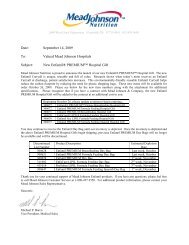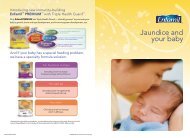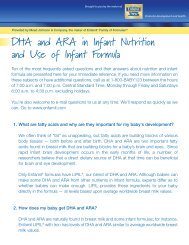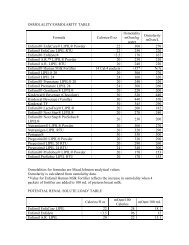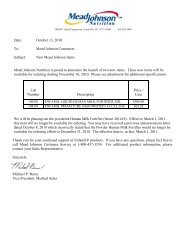LB2882MaternalNutriti+ - Mead Johnson Nutrition
LB2882MaternalNutriti+ - Mead Johnson Nutrition
LB2882MaternalNutriti+ - Mead Johnson Nutrition
Create successful ePaper yourself
Turn your PDF publications into a flip-book with our unique Google optimized e-Paper software.
Guidelines for Physical Activity during Pregnancy and Lactation<br />
Exercise is beneficial for weight control during pregnancy and for weight loss or maintenance during the<br />
preconception, postpartum, and intrapartum periods. During pregnancy, regular physical activity may improve the<br />
possibility of gaining weight within the targeted ranges, 3 help decrease minor aches and pains, lessen constipation,<br />
improve energy level, reduce stress, and improve sleep. 77 Exercise has also been shown to improve glucose<br />
tolerance, and help prevent the development of gestational diabetes. 122,123 Research indicates that infant birth-weight<br />
is not negatively affected by moderate-intensity exercise in women who have adequate energy intake. 26,124<br />
Research indicates that the risk of an adverse pregnancy outcome associated with moderate-intensity physical<br />
activity, such as brisk walking, is very low for healthy pregnant women. 23 The US Department of Health and Human<br />
Services states, “Unless a woman has medical reasons to avoid activity during pregnancy, she can begin or continue<br />
moderate-intensity aerobic physical activity during her pregnancy and after the baby is born.” 23 The World Health<br />
Organization suggests that pregnant and postpartum women seek medical advice on how to achieve their physical<br />
activity goals. 25<br />
Women with uncomplicated pregnancies should participate in at least 150 minutes (2 hours, 30 minutes) of<br />
moderate-intensity aerobic activity a week which may be divided up into five, 30-minute walks per week or into bouts<br />
of 10-minutes of physical activity at a time. 3,23-25 Pregnant women just beginning to exercise should start slowly and<br />
gradually increase over time. 23 Exercise is not indicated for women with certain medical or obstetrical complications<br />
such as significant heart disease, restrictive lung disease or pre-eclampsia, among others. 28<br />
Certain activities are not recommended during pregnancy, including any activity involving pressure changes that could<br />
deprive the fetus of oxygen, such as scuba diving, and any activity with a high risk of falling or abdominal trauma<br />
such as downhill skiing, horseback riding, soccer, basketball, and anything with jumping or jarring motions such as<br />
high-impact aerobics classes. 23,28,77 Pregnant women should also avoid exercising while lying on their backs after the<br />
first trimester, 26,28 as it compresses the vena cava possibly causing a sudden drop in blood pressure, dizziness, or a<br />
loss of consciousness.<br />
To avoid dehydration, pregnant women need about 10 eight-ounce cups of fluid daily. 125 While there are no<br />
recommendations for fluid intake in pregnant exercisers, they will likely need more to account for losses.<br />
Most women with uncomplicated pregnancies and deliveries can begin exercising a few weeks after delivery; others<br />
will need to wait longer. A gradual return to a pre-pregnancy level of physical activity is most prudent, 26 especially for<br />
women who have cesarean deliveries and those on bed rest during pregnancy. Women should be encouraged to get<br />
regular physical activity in the post-partum period and beyond, even when weight loss is not a goal. 37<br />
Gradual weight loss resulting from exercise and calorie restriction does not appear to compromise lactation<br />
performance. 27,28,68 Severe calorie deficits, however, may impair milk production. 126 Lactating mothers should try<br />
to nurse just before exercising for prolonged periods (thirty minutes or more) to avoid discomfort 26 and should be<br />
encouraged to drink fluids before, during, and after exercise to stay hydrated. Experts recommend that lactating<br />
women consume 13 eight-ounce cups of fluid daily; 125 exercise will likely increase their fluid needs.<br />
23









